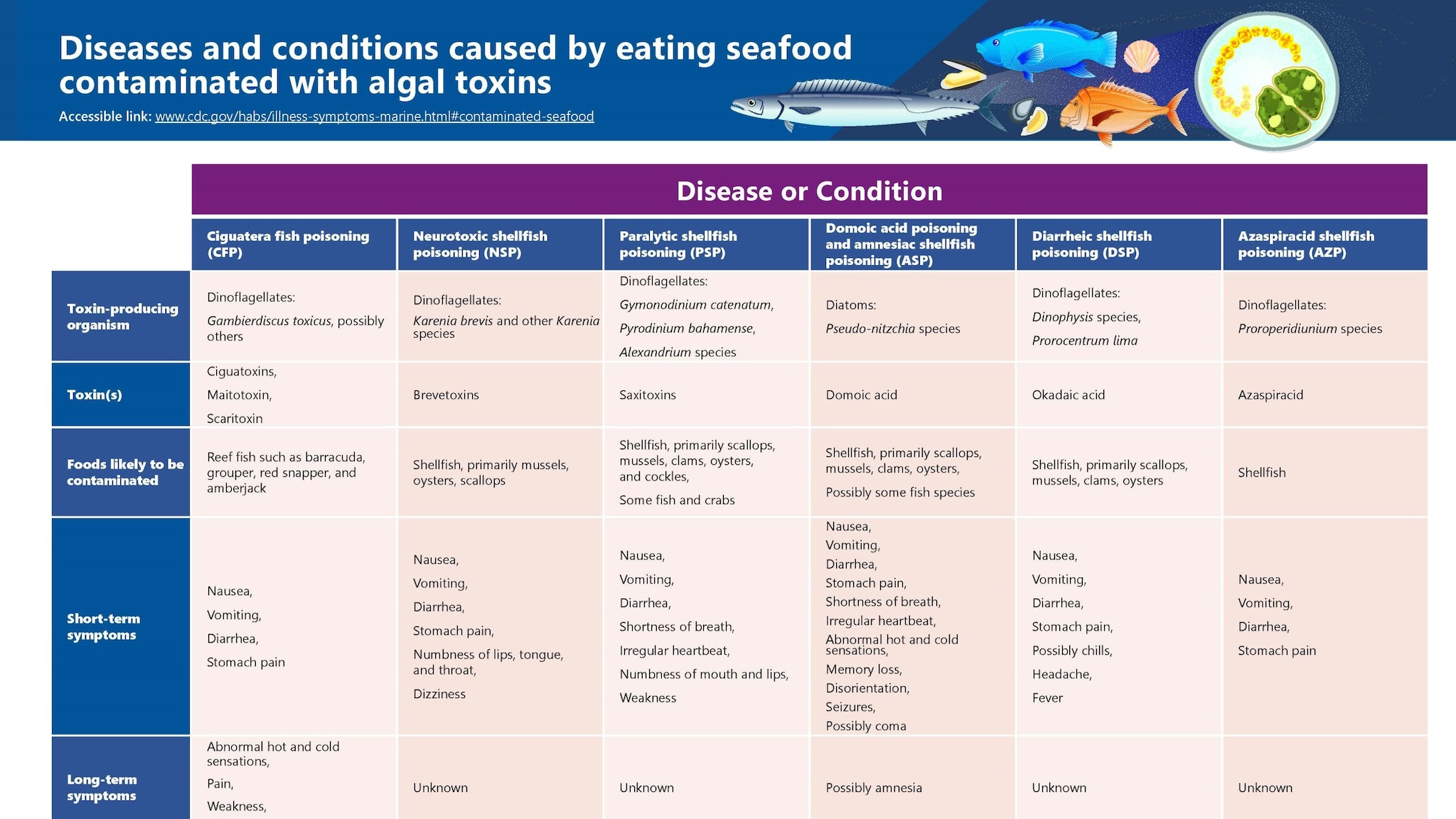Key points
- Illnesses caused by harmful algal blooms can be difficult to diagnose.
- Clinically available diagnostic testing is limited for harmful algal bloom toxins.
- Consider asking patients about possible exposures to contaminated water or food and rule out similar illnesses.
- Report cases to your health department.

Considerations
Harmful algal blooms that grow in fresh water make different toxins and often cause different illnesses than those in salt water.
Freshwater harmful algal blooms
Most harmful algal blooms in fresh water, such as lakes or rivers, are caused by cyanobacteria (also called blue-green algae). Your patient may have been exposed to cyanobacteria or the toxins they make (cyanotoxins) if they became ill after contact with:
- Fresh water
- Freshwater fish
- Blue-green algae dietary supplements
In some cases, cyanobacteria will also grow in salt water or brackish water.
Saltwater harmful algal blooms
Harmful algal blooms in salt water (such as oceans or bays) or brackish water (such as estuaries) are caused by a variety of algae that make different toxins. Your patient may have been exposed to one or more of these toxins if your patient:
- Was in or near water with a harmful algal bloom
- Ate contaminated seafood
Testing
Cyanotoxins
There are no clinically available diagnostic tests for toxins made by cyanobacteria. However, you can use the following tests to evaluate illnesses related to cyanotoxins:
- Electrolytes and liver enzymes
- Renal function tests, serum glucose, and urine tests to check for proteinuria and glycosuria (in cases of severe toxicity)
- Chest radiograph, if respiratory symptoms are present
Specialized laboratories can test for cyanobacteria or cyanotoxins in feces, urine, stomach contents (if available), tissues, serum, or water specimens. The U.S. Environmental Protection Agency (EPA) website lists laboratories that can analyze water samples for cyanobacteria and cyanotoxins.
Toxins from saltwater harmful algal blooms
Laboratories may be able to test human samples for some types of harmful algal bloom toxins. For foodborne illnesses, the U.S. Food and Drug Administration (FDA) may be able to test the seafood your patient ate for toxins.
Diagnosis
Freshwater harmful algal bloom-associated illnesses
Assess exposure
Illnesses caused by harmful algal blooms of cyanobacteria are primarily diagnoses of exclusion because of limited available clinical testing for toxins.
Consider asking your patient about their contact with bodies of water, such as lakes or rivers. Doing activities in or near contaminated water is the most common way people are exposed. You may also consider asking about other sources of exposure, such as contaminated food, dietary supplements, or tap water.
Pet illness may provide additional evidence that a patient could have an illness caused by a harmful algal bloom. Dogs and other animals often have more severe signs of illness than people, including collapse and sudden death.
Rule out similar illnesses
The following illnesses, conditions, and exposures to chemicals can cause similar signs and symptoms as those causes by some types of cyanobacteria or cyanotoxins:
- Organophosphate poisoning
- Mushroom poisoning
- Drug overdose
- Chemical burns
- Exposure to irritants
- Acetaminophen poisoning
Saltwater harmful algal bloom-associated illnesses
To help you diagnose illnesses caused by harmful algal blooms in salt water:
- Ask patients about possible exposure to contaminated water or seafood
- Consider using available laboratory tests
Reporting cases
Contact your local or state health department to report a harmful algal bloom-related health event.
ICD-10-CM codes
You can use the following codes to record your diagnosis of harmful algal bloom-associated illnesses:
- T65.82 Toxic effect harmful algae and algae toxins
- Z77.121 Contact with and (suspected) exposure to harmful algae and algae toxins
Resources
- Cyanobacterial Blooms and Associated Illnesses: A Clinician Training Module for Physicians and Healthcare Providers | ASTHO
- Food Poisoning from Marine Toxins | CDC Yellow Book
- Distribution of Harmful Algal Blooms in the U.S. | Woods Hole Oceanographic Institution

